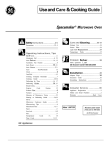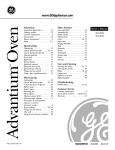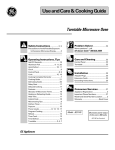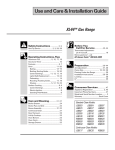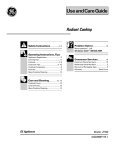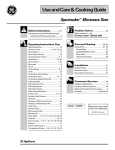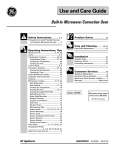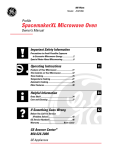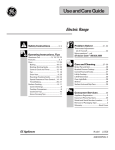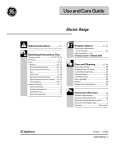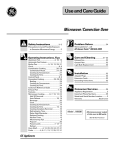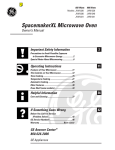Download GE Spacemaker JVM231 User's Manual
Transcript
UseandCare& Cooking Guide Spacemaker® Microwave Oven Problem Solver...............................25 Safety Instructions ....................3–5 Precautions to Avoid Possible Exposure to Excessive Microwave Energy.............2 More questions ?…call Operating Instructions, Tips Care and Cleaning ....................21–23 Aluminum Foil ...........................4, 16, 17, 19 Auto Defrost..................................................15 Auto Defrost Guide......................................16 Automatic Fan Feature.............................5, 7 Clock ..................................................................8 Control Panel...............................................8, 9 Cooking by Time ...................................12, 13 Cooking Complete Reminder ...................10 Cooking Guide ..............................................20 Defrosting by Time ......................................14 Defrosting Guide ......................................19 Delayed Cooking ......................................11 Delay Start .....................................................13 Exhaust Fan..........................................5, 7, 23 Express Cook Feature .................................13 Features..........................................................10 Glossary of Microwave Terms..................17 Heating or Reheating Guide ..................18 Hold Time ...................................................11 Kitchen Timer................................................11 Microwaving Tips ...........................................6 Popcorn ..........................................................13 Power Levels ......... 7, 8, 11, 12, 14, 18–20 Exhaust Fan ...................................................23 Grease Filter...............................................23 Light Bulb Replacement .........................22 GE Appliances GE Answer Center® 800.626.2000 Installation ..........................................24 Adapter Plugs ...............................................24 Extension Cords ...........................................24 Grounding Instructions...............................24 Consumer Services ...................27 Appliance Registration..................................2 Important Phone Numbers........................27 Model and Serial Number Location...........2 Warranty ........................................Back Cover Models: JVM230 JVM231 Microwave power output of this oven is 850 watts. HELP US HELP YOU… Before using your oven, read this guide carefully. Be sure your microwave oven is registered. Save time and money. Before you request service... It is intended to help you operate and maintain your new microwave oven properly. Keep it handy for answers to your questions. If you don’t understand something or need more help, call: GE Answer Center® 800.626.2000 24 hours a day, 7 days a week It is important that we know the location of your microwave oven should a need occur for adjustments. Your supplier is responsible for registering you as the owner. Please check with your supplier to be sure he has done so; also send in your Consumer Product Ownership Registration Card. If you move, or if you are not the original purchaser, please write to us, stating model and serial numbers. This appliance must be registered. Please be certain that it is. Write to: GE Appliances Range Product Service Appliance Park Louisville, KY 40225 Check the Problem Solver in the back of this guide. It lists causes of minor operating problems that you can correct yourself. Write down the model and serial numbers. You’ll find them on a label inside the oven. These numbers are also on the Consumer Product Ownership Registration Card that came with your microwave oven. Before sending in this card, please write these numbers here: Model Number If you received a damaged oven... Serial Number Immediately contact the dealer (or builder) that sold you the oven. Use these numbers in any correspondence or service calls concerning your microwave oven. All these things are normal with your microwave oven. • Steam or vapor escaping from around the door. • Light reflection around door or outer case. • Dimming oven light and change in blower sound may occur while operating at power levels other than high. • Dull thumping sound while oven is operating. • Some TV-Radio interference might be noticed while using your microwave oven. It’s similar to the interference caused by other small appliances and does not indicate a problem with your oven. PRECAUTIONS TO AVOID POSSIBLE EXPOSURE TO EXCESSIVE MICROWAVE ENERGY (a) Do Not Attempt to operate this oven with the door open since open-door operation can result in harmful exposure to microwave energy. It is important not to defeat or tamper with the safety interlocks. (b) Do Not Place any object between the oven front face and the door or allow soil or cleaner residue to accumulate on sealing surfaces. 2 (c) Do Not Operate the oven if it is damaged. It is particularly important that the oven door close properly and that there is no damage to the: (1) door (bent) (2) hinges and latches (broken or loosened) (3) door seals and sealing surfaces. (d) The Oven Should Not be adjusted or repaired by anyone except properly qualified service personnel. IMPORTANT SAFETY INSTRUCTIONS Read All Instructions Before Using Your Appliance. When using electrical appliances, basic safety precautions should be followed, including the following: WARNING–To reduce the risk of • Do not mount this appliance over a sink. Install or locate this appliance only in accordance with the provided Installation Instructions. • Do not cover or block any openings on the appliance. • Do not store this appliance outdoors. Do not use this product near water—for example, in a wet basement, near a swimming pool or near a sink. • This microwave oven is not approved or tested for marine use. • Do not store anything directly on top of the microwave oven surface when the oven is in operation. • Do not immerse power cord or plug in water. • Keep power cord away from heated surfaces. • To reduce the risk of fire in the oven cavity: —Do not overcook food. Carefully attend appliance if paper, plastic or other combustible materials are placed inside the oven to facilitate cooking. —Remove wire twist-ties and metal handles from paper or plastic containers before placing them in the oven. —Do not use your microwave oven to dry newspapers. —Do not use recycled paper products. Recycled paper towels, napkins and waxed paper can contain metal flecks which may cause arcing or ignite. Paper products containing nylon or nylon filaments should be avoided, as they may also ignite. —Do not pop popcorn in your microwave oven unless in a special microwave popcorn accessory or unless you use popcorn labeled for use in microwave ovens. —Do not overcook potatoes. They could dehydrate and catch fire, causing damage to your oven. —Do not operate the oven while empty to avoid damage to the oven and the danger of fire. If by accident the oven should run empty a minute or two, no harm is done. However, try to avoid operating the oven empty at all times—it saves energy and prolongs the life of the oven. (continued next page) 3 Important Safety Instructions burns, electric shock, fire, injury to persons or exposure to excessive microwave energy: • Read and follow the specific ‘‘Precautions to Avoid Possible Exposure to Excessive Microwave Energy’’ on the previous page. • This appliance must be grounded. Connect only to properly grounded outlet. See Grounding Instructions section in the back of this guide. • Use this appliance only for its intended use as described in this guide. Do not use corrosive chemicals or vapors in this appliance. This microwave oven is specifically designed to heat or cook food, and is not intended for laboratory or industrial use. • This over-the-range oven was designed for use over ranges no wider than 42 inches. It may be installed over both gas and electric cooking equipment. • For best operation, plug this appliance into its own electrical outlet, to prevent flickering of lights, blowing of fuse or tripping of circuit breaker. • Do not let power cord hang over edge of table or counter. • Do not operate this appliance if it has a damaged power cord or plug, if it is not working properly, or if it has been damaged or dropped. • See door surface cleaning instructions in the Care and Cleaning section(s) of this guide. • This appliance should be serviced only by qualified service personnel. Contact nearest authorized service facility for examination, repair or adjustment. • As with any appliance, close supervision is necessary when used by children. IMPORTANT SAFETY INSTRUCTIONS (continued) —Do not use the oven for storage purposes. Do not leave paper products, cooking utensils or food in the oven when not in use. —If materials inside oven should ignite, keep oven door closed, turn oven off, and disconnect power cord, or shut off power at the fuse or circuit breaker panel. • Some products such as whole eggs and sealed containers—for example, closed jars—will explode and should not be heated in this microwave oven. Such use of the microwave oven could result in injury. • Avoid heating baby food in glass jars, even with the lid off. Make sure all infant food is thoroughly cooked. Stir food to distribute the heat evenly. Be careful to prevent scalding when warming formula or breast milk. The container may feel cooler than the milk really is. Always test the milk before feeding the baby. • Don’t defrost frozen beverages in narrow necked bottles (especially carbonated beverages). Even if the container is opened, pressure can build up. This can cause the container to burst, possibly resulting in injury. • Use foil only as directed in this guide. TV dinners may be microwaved in foil trays less than 3/4″ high; remove the top foil cover and return the tray to the box. When using foil in the microwave oven, keep the foil at least 1 inch away from the sides of the oven. • Cookware may become hot because of heat transferred from the heated food. Pot holders may be needed to handle the cookware. • Foods cooked in liquids (such as pasta) may tend to boil over more rapidly than foods containing less moisture. Should this occur, refer to the Care and Cleaning section(s) for instructions on how to clean the inside of the oven. • Thermometer—Do not use a thermometer in food you are microwaving unless the thermometer is designed or recommended for use in the microwave oven. 4 • Plastic cookware—Plastic cookware designed for microwave cooking is very useful, but should be used carefully. Even microwave-safe plastic may not be as tolerant of overcooking conditions as are glass or ceramic materials and may soften or char if subjected to short periods of overcooking. In longer exposures to overcooking, the food and cookware could ignite. For these reasons: 1) Use microwave-safe plastics only and use them in strict compliance with the cookware manufacturer’s recommendations. 2) Do not subject empty cookware to microwaving. 3) Do not permit children to use plastic cookware without complete supervision. • When cooking pork, follow the directions exactly and always cook the meat to an internal temperature of at least 170°F. This assures that, in the remote possibility that trichina may be present in the meat, it will be killed and meat will be safe to eat. • Do not boil eggs in a microwave oven. Pressure will build up inside egg yolk and will cause it to burst, possibly resulting in injury. • Foods with unbroken outer ‘‘skin’’ such as potatoes, sausages, tomatoes, apples, chicken livers and other giblets, and egg yolks (see previous caution) should be pierced to allow steam to escape during cooking. • Not all plastic wrap is suitable for use in microwave ovens. Check the package for proper use. • Spontaneous boiling—Under certain special circumstances, liquids may start to boil during or shortly after removal from the microwave oven. To prevent burns from splashing liquid, we recommend the following: before removing the container from the oven, allow it to stand in the oven for 30 to 40 seconds after the oven has shut off. Do not boil liquids in narrow-necked containers such as soft drink bottles, wine flasks and especially narrow-necked coffee cups. Even if the container is opened, excessive steam can build up and cause it to burst or overflow. —In the event of a grease fire, smother flaming pan on surface unit by covering pan completely with well-fitting lid, cookie sheet or flat tray. —Clean the vent hood often. Do not allow grease to build up on the hood or the filter. —Use care when cleaning the vent hood filter. Corrosive cleaning agents, such as lye-based oven cleaners, may damage the filter. —When flaming foods are under the hood, turn the fan off. The fan, if operating, may spread the flame. Important Safety Instructions • ‘‘Boilable’’ cooking pouches and tightly closed plastic bags should be slit, pierced or vented as directed by package. If they are not, plastic could burst during or immediately after cooking, possibly resulting in injury. Also, plastic storage containers should be at least partially uncovered because they form a tight seal. When cooking with containers tightly covered with plastic wrap, remove covering carefully and direct steam away from hands and face. • Hot foods and steam can cause burns. Be careful when opening any containers of hot food, including popcorn bags, cooking pouches and boxes. To prevent possible injury, direct steam away from hands and face. SAVE THESE INSTRUCTIONS The Exhaust Hood • Have it installed and properly grounded by a qualified installer. See the special installation booklet packed with the microwave oven. • The exhaust fan in the oven will operate automatically under certain conditions (see Automatic Fan Feature). While the fan is operating, caution is required to prevent the starting and spreading of accidental cooking fires while the exhaust fan is in use. For this reason: —Never leave surface units unattended at high heat settings. Boilovers cause smoking and greasy spillovers that may ignite and spread if exhaust fan is operating. To minimize automatic fan operation, use adequate sized cookware and use high heat only when necessary. Optional Accessories Available at extra cost from your GE supplier. JX40WH Filler Panel Kit (for models JVM230WV and JVM231WV). JX41 Filler Panel Kit (for models JVM230BV and JVM231BV). JX50 Glass Canopy Kit JX81A Charcoal Filter Kit for non-vented installation. This microwave oven is UL listed for installation over electric and gas ranges. 5 IF YOU NEED SERVICE… To obtain service, see the Consumer Services page in the back of this guide. We’re proud of our service and want you to be pleased. If for some reason you are not happy with the service you receive, here are 3 steps to follow for further help. FIRST, contact the people who serviced your appliance. Explain why you are not pleased. In most cases, this will solve the problem. NEXT, if you are still not pleased, write all the details—including your phone number—to: Manager, Consumer Relations GE Appliances Appliance Park Louisville, KY 40225 FINALLY, if your problem is still not resolved, write: Major Appliance Consumer Action Panel 20 North Wacker Drive Chicago, IL 60606 MICROWAVING TIPS • Make sure all cookware used in your microwave oven is suitable for microwaving. Most glass casseroles, cooking dishes, measuring cups, custard cups, pottery or china dinnerware which does not have metallic trim or glaze with a metallic sheen can be used. Some cookware is labeled “suitable for microwaving.” • If you are not sure if a dish is microwave-safe, use this test: Place in the oven both the dish you are testing and a glass measuring cup filled with 1 cup of water—set the measuring cup either in or next to the dish. Microwave 1 minute at high. If the dish heats, it should not be used for microwaving. If the dish remains cool and only the water in the cup heats, then the dish is microwave-safe. 6 • Paper towels, waxed paper and plastic wrap can be used to cover dishes in order to retain moisture and prevent spattering. Be sure to vent plastic wrap so steam can escape. • Some microwaved foods require stirring, rotating or rearranging. Check the Cooking Guide. • Steam builds up pressure in foods which are tightly covered by a skin or membrane. Pierce potatoes, egg yolks and chicken livers to prevent bursting. If you use a meat thermometer while cooking, make sure it is safe for use in microwave ovens. How to Change Power Level 1. Press MICRO COOK or TIME DEFROST. 2. Select cooking or defrosting time. 1 2 3. Press POWER LEVEL. 4 5 4. Select desired power level 1–10. 7 8 5. Press START. 0 3 EXPRESS COOK EXPRESS COOK EXPRESS COOK EXPRESS COOK EXPRESS COOK 6 9 POWER LEVEL High 10 Med-High 7 Medium 5 Low 3 Warm 1 BEST USES Fish, bacon, vegetables, boiling liquids. Gentle cooking of meat and poultry; baking casseroles and reheating. Slow cooking and tenderizing such as stews and less tender cuts of meat. Defrosting without cooking; simmering; delicate sauces. Keeping food warm without overcooking; softening butter. This microwave oven has an automatic fan feature to protect it from too much heat rising from the cooktop or range beneath it. It automatically turns on at a low speed if it senses too much heat. If you have turned the fan on you may find that you cannot turn it off. This is because the automatic fan has come on to protect the internal parts of the microwave. The fan will automatically turn off when the internal parts are cool. It may stay on for 30 minutes or more after the range and microwave controls have been turned off. Variable Power Levels AUTOMATIC FAN FEATURE Microwaving Tips Variable power levels add flexibility to your microwave cooking. The power levels on your microwave oven can be compared to the surface units on a range. High (Power Level 10) or full power is the fastest way to cook and gives you 100% power. Each power level gives you microwave energy a certain percent of the time. Power Level 7 is microwave energy 70% of the time. Power Level 3 is energy 30% of the time. A high setting (10) will cook faster but may need additional attention such as frequent stirring, rotating or turning over. Most of your cooking will be done on High (Power Level 10). A lower setting will cook more evenly and with less attention given to stirring or rotating the food. Some foods may have better flavor, texture or appearance if one of the lower settings is used. You may wish to use a lower power level when cooking foods that have a tendency to boil over, such as scalloped potatoes. Rest periods (when the microwave energy cycles off) give time for the food to “equalize” or transfer heat to the inside of the food. An example of this is shown with Power Level 3—the defrost cycle. If microwave energy did not cycle off, the outside of the food would cook before the inside was defrosted. Here are some examples of uses for various power levels: If You Need Service… VARIABLE POWER LEVELS (1–10) Auto Fan Feature 7 YOUR TOUCH CONTROL PANEL The Touch Control Panel allows you to set the oven controls with the touch of a finger. It’s designed to be easy to use and understand. 1. DISPLAY. Displays time of day, cooking time, power level being used, cooking mode and instructions. 2. TIME DEFROST. Gentle thawing at automatic Power Level 3 (Low). 3. MICRO COOK. Microwave for a selected amount of time using automatic Power Level 10 (High). 4. EXPRESS COOK. Touch number pads 1 through 5 for 1 to 5 minutes of cooking. No need to touch START, the oven will start immediately. 5. NUMBER PADS. Touch these pads to program the microwave. 6. POWER LEVEL. Touch this pad before entering another power level number if you want to change from automatic Power Level 10 (High) for cooking or Power Level 3 (Low) for defrosting. 7. KITCHEN TIMER. This feature uses no microwave energy. It functions as either a kitchen timer, as a holding period after defrost or as a delay timer before time cooking. 8. CLOCK. Touch this pad to enter time of day or check time of day while microwaving. To set clock, first touch CLOCK pad and then enter time of day. For example, if time is 1:30, touch number pads 1, 3 and 0 and ‘‘1:30’’ will appear in display. Then touch START or CLOCK pad. To reset or change time, simply repeat above process. 9. AUTO DEFROST. Touch this pad and food weight, then START. The oven automatically sets power levels and defrosting time. 10. POPCORN. Touch this pad to cook prepackaged microwave popcorn weighing 3.0 to 3.5 ounces. No need to touch START, the oven will start immediately. 11. START. After all selections are made, touch this pad to start the oven. 12. CLEAR/OFF. When touched, it shuts off the oven and erases all settings (except time of day). 13. DELAY START. Allows you to program your oven to begin cooking at a preset time of day— up to a 12-hour delay. 14. CLOCK DISPLAY ON/OFF. Touch the 0 number pad to turn the clock display on or off. The Clock Display On/Off feature cannot be used while a cooking feature is in use. 15. SURFACE LIGHT. Touch ON to turn on the surface light. 16. VENT FAN. Press HI, LO or OFF for the different fan speeds. When You Plug in the Oven The display panel displays “88888”, “18 POWER” and all of the oven functions. After 15 seconds, all lights disappear and ‘‘RESET’’ appears in the upper portion. Touch the CLEAR/OFF pad, set the Clock and oven is ready for use. This will happen any time there is a power outage. 8 ENTER FOOD TEMP COOK NO WEIGHT LBS. DEF TIME I II 1 POWER SOUND CODE 2 4 TIME DEFROST MICRO COOK 1 EXPRESS COOK 4 5 6 AUTO DEFROST 2 POPCORN 10 START 11 CLEAR OFF 12 Your Touch Control Panel 3 9 3 EXPRESS COOK EXPRESS COOK EXPRESS COOK EXPRESS COOK 5 6 7 8 9 POWER LEVEL 0 DELAY START DISPLAY ON/OFF 13 14 TIME 7 8 KITCHEN TIMER CLOCK VENT FAN OFF LO SURFACE LIGHT HI OFF ON 15 16 9 FEATURES OF YOUR OVEN 1 2 3 4 POWER ENTERFOOD TEMP COOK NO SOUND WEIGHTLBS. DEF TIME I II CODE TIME DEFROST MICRO COOK 1 2 EXPRESS COOK 7 9 1. Door Handle. Pull to open door. Door must be securely latched for oven to operate. 2. Door Latches. 3. Window with Metal Shield. Screen allows cooking to be viewed while keeping microwaves confined in oven. 4. Touch Control Panel and Digital Display. For detailed information on each feature, see Your Touch Control Panel section. Cooking Complete Reminder (For all cooking features) To remind you that you have food in the oven, the oven will display ‘‘End’’ and beep once a minute until you either open the oven door or touch the CLEAR/OFF pad. 10 8 7 START 6 8 9 0 DELAY START DISPLAY ON/OFF TIME 6 EXPRESS COOK 5 EXPRESS COOK POWER LEVEL VENT FAN CLOCK OFF POPCORN 3 EXPRESS COOK 4 EXPRESS COOK KITCHEN TIMER AUTO DEFROST LO CLEAR OFF SURFACE LIGHT HI OFF ON 5 6 5. Hood Controls. Vent Fan. Press HI, LO or OFF. Surface Light. Press ON or OFF. 6. Grease Filters. 7. Cooktop Light. 8. Automatic Cooking Guide. 9. Oven Floor. NOTE: Rating plate, oven vent(s) and oven light are located on the inside walls of the microwave oven. This is to certify that this unit has been tested in conformance with AMCA Bulletin No. 210. C.F.M. at 0.10 WG 300 Vert. 300 Hor. SONES 7.2 Vert. 6.8 Hor. HOW TO USE THE KITCHEN TIMER Using a Holding Time The Kitchen Timer has three timing functions: • It operates as a minute timer. • It can be set to delay cooking. • It can be used as a hold setting after defrosting. The Kitchen Timer operates without microwave energy. The Kitchen Timer can also be used to program a “holding time” between microwave cooking functions. The time can range from one second to 99 minutes and 99 seconds. A holding or standing time may be found in some of your own recipes or in a cookbook. How to Time a 3-Minute Phone Call Programming Delayed Cooking KITCHEN TIMER Step 1: Touch KITCHEN TIMER pad. Step 2: Touch number pads 3, 0 and 0 (for 3 minutes and no seconds). Step 3: Touch START. Display shows time counting down. The timer signals when START time is up. To delay cooking up to 99 minutes and 99 seconds, touch MICRO COOK and enter cook time. Touch KITCHEN TIMER and enter number of minutes to delay cooking. Touch START. Timer will count down to zero and cooking will begin. Features of Your Oven The Kitchen Timer How to Defrost, Hold and Micro Cook Let’s say you want to defrost a frozen casserole for 15 minutes, hold for 10 minutes and then Micro Cook for 25 minutes. Here’s how to do it: Step 1: Take casserole from freezer and place in oven. Step 2: Touch TIME DEFROST. Step 3: Touch pads 1, 5, 0 and 0 for 15 minutes defrosting time. Defrosting is automatically set on Power Level 3 but can be changed by touching the POWER LEVEL pad and the desired power level 1–10. Step 4: Set standing or hold time by KITCHEN touching KITCHEN TIMER. MICRO COOK Step 7: Touch 2, 5, 0 and 0 for 25 minutes of cooking time. Step 8: Touch START. As each function is automatically performed, oven display START shows instructions entered and the function. When time is up, the oven signals and flashes “End”. TIMER 11 How to Use the Kitchen Timer TIME DEFROST Step 5: Touch 1, 0, 0 and 0 to hold for ten minutes. Step 6: Touch MICRO COOK. COOKING BY TIME Micro Cook I Micro Cook allows you to microwave for a preset amount of time. Power Level 10 (High) is recommended for most cooking, but you may change this for more flexibility. See the Cooking Guide. To become better acquainted with time cooking, make a cup of coffee by following the steps below. Step 1: Fill a cup 2/3 full of water, add 1 teaspoon of instant coffee and stir to dissolve. Use a cup that has no metal decoration and is microwavesafe (refer to Microwaving Tips section). Place cup in oven and close door. Step 2: Touch MICRO COOK. MICRO COOK Step 3: Select your time. Touch pads 1, 0 and 0 for 1 minute. Because automatic Power Level 10 is recommended for this cup of coffee, there is no need to change the power level. (If Power Level 10 is not appropriate, see ‘‘How to Change Power Level’’ below.) Step 4: Touch START. START Step 5: When time is up, the oven signals and flashes ‘‘End’’. The oven, light and fan shut off. Step 6: Open the door. If you interrupt Micro Cook to check the food, simply close the door and press START to resume cooking. If there is not time remaining on the timer you must reset the timer to resume cooking. How to Change Power Level When Setting Micro Cook I 1. Press MICRO COOK. 1 2 2. Select cooking time. 4 5 3. Press POWER LEVEL. 7 8 4. Select desired power level 1–10. 0 5. Press START. 3 EXPRESS COOK EXPRESS COOK EXPRESS COOK EXPRESS COOK EXPRESS COOK 6 9 Using the Micro Cook II Feature The Micro Cook II feature lets you set 2 time cooking functions within one program. This is ideal if you want to change power levels during your cooking operations. Here’s how to do it. Step 1: Place the food in the oven in a microwavesafe container and close the door. Step 2: Touch MICRO COOK. MICRO COOK Step 3: Select your first cook time. For example, touch 2, 1 and 5 for 2 minutes and 15 seconds. Step 4: Now is the time to change the power level if you don’t want full power for MICRO COOK. (Press POWER LEVEL. Select desired power level 1–10.) Step 5: Touch MICRO COOK again. Step 6: Set your second cook time. Step 7: Change the power level for MICRO COOK. (Press POWER LEVEL. Select desired power level 1–10.) 12 Step 8: Press START. START The microwave oven will start and the time set for “COOK TIME I” will count down. Also, “POWER 10” or the power level selected for “COOK TIME I” will be displayed. At the end of “COOK TIME I”, the second power level is displayed and the time for “COOK TIME II” is shown counting down. When time is up, the oven signals and flashes “End”. The oven, light and fan shut off. Open the door. If you interrupt Micro Cook to check the food, simply close the door and press START to resume cooking. If there is no time remaining on the timer you must reset the timer to resume cooking. The Express Cook Feature The Express Cook feature is a short-cut method to set time for 1-5 minutes. 4 2 EXPRESS COOK 3 EXPRESS COOK EXPRESS COOK EXPRESS COOK 5 6 7 8 9 0 How to Use Delay Start The Delay Start feature allows you to program your oven to begin cooking at a preset time of day—up to a 12-hour delay. Step 1: Touch DELAY START pad. DELAY START Step 2: Enter the time you want the oven to start. (Be sure your microwave oven clock shows the correct time of day.) Step 3: Enter your desired cooking program. Step 4: Touch START pad. The oven will automatically start at the desired time. Cooking by Time 1 EXPRESS COOK To Express Cook your food or beverage: Touch a number pad (from 1 to 5) for 1 to 5 minutes of cooking at Power Level 10. For example, touch the 2 pad for 2 minutes of cooking time. No need to touch START, the oven will start immediately. The oven will signal and turn off automatically when finished. POPCORN The Popcorn feature is designed to be used only with prepackaged microwave popcorn weighing 3.0 to 3.5 ounces. Step 1: Remove the outer wrapper from the microwave popcorn. Step 2: Open oven door and place package of popcorn in the center of the oven floor as directed by the package instructions. Close oven door. Step 3: Touch POPCORN pad. No need to touch START, the oven POPCORN will start immediately. How to Adjust the Popcorn Program to Provide a Shorter or Longer Cook Time Touch the POPCORN pad. (The oven will start immediately.) Then touch number pad 9. A plus sign will appear on the display beside the word “POP”. The plus sign indicates 20 seconds more cooking time is being provided. If your favorite popcorn is overcooked, there is a simple adjustment you can make. Touch the POPCORN pad. (The oven will start immediately.) Then touch number pad 1. A minus sign will appear on the display beside the word “POP”. The minus sign indicates 20 seconds less cooking time is being provided. Popcorn If your favorite popcorn is not completely popped, there is a simple adjustment you can make. 13 DEFROSTING BY TIME Time Defrost (Power Level 3) Time Defrost is designed for speedy thawing of frozen food and is one of the great advantages of a microwave oven. Use the Time Defrost setting to quickly thaw foods such as bread, rolls, vegetables, fruits and frozen dinners. The Auto Defrost setting is preferred for meat and poultry because the oven sets the defrosting time and power levels for you. • Power Level 3 is automatically set when you press TIME DEFROST pad, but you may change this for more flexibility. • See the Defrosting Guide for defrosting help. How to Change Power Level 1. Press TIME DEFROST. 2. Select defrosting time. 3. Press POWER LEVEL. 4. Select desired power level 1–10. 1 EXPRESS COOK 4 2 EXPRESS COOK 3 EXPRESS COOK EXPRESS COOK EXPRESS COOK 5 6 7 8 9 0 To become better acquainted with the defrost function, defrost a 10 oz. package of frozen strawberries by following the steps below. Step 1: Place a package of frozen strawberries in the oven and close door. Be sure package contains no metal. Step 2: Touch TIME DEFROST. TIME DEFROST Step 3: Select one half of the total defrosting time recommended. For example, touch pads 4, 0 and 0 for 4 minutes. Step 4: Touch START. When the cycle is completed, the oven signals and flashes START “End”, then automatically shuts off. Step 5: Turn the package over, close the door and repeat Steps 2 and 3 to set remaining half of defrosting time. Touch START. Step 6: When the oven signals and flashes “End”, open the door, remove the package and separate strawberries to finish defrosting. Defrosting Tips • Foods frozen in paper or plastic can be defrosted in the package. Tightly closed packages should be slit, pierced or vented, AFTER food has partially defrosted, as directed by package. Plastic storage containers should be at least partially uncovered. • Family-size, pre-packaged frozen dinners can be defrosted and microwaved. If the food is in a foil container, transfer it to a microwave-safe dish. • For even defrosting, some foods need to be broken up or separated part of the way through the defrosting time. • Foods that spoil easily, such as milk, eggs, fish, stuffings, poultry and pork should not be allowed to sit out for more than one hour after defrosting. Room temperature promotes the growth of harmful bacteria. • Check the Defrosting Guide for other defrosting tips. Questions and Answers Q. When I press START, I hear a dull thumping noise. What is it? A. This sound is normal. It is letting you know the magnetron is in operation. 14 Q. Can I defrost small items in a hurry? A. Yes, but they will need more frequent attention than usual. Raise the power level after entering the time by touching the desired power level pad. Power Level 7 cuts the total defrosting time in about 1/2; Power Level 10 cuts the total defrosting time to approximately 1/3. During either, rotate or stir food frequently. AUTO DEFROST Auto Defrost Use the Auto Defrost Guide. Enter the food weight in pounds and tenths of a pound (see Conversion Guide below). Then touch START pad. The oven calculates defrosting time and changes power levels during defrosting to give even defrosting results. How to Set Auto Defrost Before you begin, check the guide located on the inside front of oven when you open the door. It shows minimum and maximum food weights for a variety of foods. You will need to know your food weight before setting Auto Defrost. Step 1: Remove food from package, place in oven on microwave-safe dish and close door. Step 2: Touch AUTO DEFROST pad. AUTO DEFROST Step 3: Enter weight. For example, touch number pads 1 and 2 for weight of 1.2 pounds (1 pound, 3 ounces). See Conversion Guide below. After approximately 5 seconds “START” flashes. Stand Time After Auto Defrosting, meat needs to stand in order to let the inside defrost. You may take the food out of the oven if you wish. Stand time recommendations are given in the Auto Defrost Guide. START Step 4: Touch START pad. Display shows defrost time counting down. Twice during defrosting, the oven beeps 4 times and ‘‘TURn’’ flashes. Follow the directions in the Auto Defrost Guide for what to do at the first and second signal. Then close the door and touch START pad. When defrosting time is completed, ‘‘End’’ flashes and oven beeps 4 times. ‘‘End’’ remains on display and oven beeps every minute until door is opened or CLEAR/OFF pad is touched. Defrosting by Time With the Auto Defrost feature, the oven automatically sets the defrosting times and power levels for you. Conversion Guide Auto Defrost If the weight of food is stated in pounds and ounces, the ounces must be converted to tenths (.1) of a pound. Ounces Pounds 1–2 .1 3 .2 4–5 .3 6–7 .4 8 .5 9–10 .6 11 .7 12–13 .8 14–15 .9 15 AUTO DEFROST GUIDE RECOMMENDED FOODS MIN.–MAX. WEIGHT FIRST SIGNAL SECOND SIGNAL STAND TIME Chops 0.1 - 6.0 lbs. Turn over. Separate and shield where necessary. 5 minutes Frankfurters, Sausage 0.1 - 6.0 lbs. Separate. Remove defrosted pieces. 2 minutes Ground Meat 0.1 - 6.0 lbs. Turn over. Remove defrosted areas and break apart. 5 minutes Beef Patties 0.1 - 6.0 lbs. Turn over. Separate patties. 5 minutes Roast 0.1 - 6.0 lbs. Turn over and shield. Shield if necessary. 30 minutes Ribs 0.1 - 6.0 lbs. Turn over. Remove defrosted pieces. Shield if necessary. 10 minutes Steak 0.1 - 6.0 lbs. Turn over. Stew 0.1 - 6.0 lbs. Turn over and separate. Separate and remove defrosted pieces. 5 minutes Whole Chicken 0.1 - 6.0 lbs. Turn over and shield. Turn over and shield. 10 minutes; run cold water in cavity. Turkey Breast (breast side up) 0.1 - 6.0 lbs. Turn over. Shield where necessary. 20 minutes; run cold water in cavity. Chicken Pieces 0.1 - 6.0 lbs. Turn over. Separate and remove defrosted pieces. 5 minutes Cornish Hens (whole) 0.1 - 6.0 lbs. Remove wrapper and turn over. 10 minutes; run cold water in cavity. Cornish Hens (split) 0.1 - 6.0 lbs. Turn over. 5 minutes Fish Fillets 0.1 - 6.0 lbs. Turn over. Separate and remove defrosted pieces. 5 minutes Shrimp, Scallops 0.1 - 6.0 lbs. Separate. Separate and remove defrosted pieces. 5 minutes Whole Fish 0.1 - 6.0 lbs. Turn over and shield tail and head. Meat 5 minutes Poultry Seafood Edges or thin areas of meat will defrost more rapidly than other areas. After first or second signal, shield warm areas with small pieces of foil. 16 Hold under cold running water. GLOSSARY OF MICROWAVE TERMS Basic Microwave Guidelines Density of Food. In both regular baking and microwave cooking, dense foods, such as potatoes, take longer to cook than light, porous foods, such as rolls, bread or pieces of cake. Round Shapes. Since microwaves penetrate foods to about 1 inch from top, bottom and sides, round shapes and rings cook more evenly. Corners receive more energy and may overcook. This may also happen when cooking in a regular oven. Delicacy. Foods with a delicate texture, such as custards, are best cooked at lower power settings to avoid toughening. Natural Moisture of food affects how it cooks. Very moist foods cook evenly because microwave energy is attracted to water molecules. Food that is uneven in moisture should be covered or allowed to stand so it heats evenly. Piece Size. Small pieces cook faster than large ones. Pieces that are similar in size and shape cook more evenly. With large pieces of food, reduce the power setting for even cooking. Shape of Food. In both types of cooking, thin areas cook faster than thick areas. This can be controlled in microwaving by placing thick pieces near the outside edge and thin pieces in the center. Starting Temperature. Foods taken from the freezer or refrigerator take longer to cook than foods at room temperature. Timings in our recipes are based on the temperatures at which you normally store the foods. Quantity of Food. In both types of cooking, small amounts usually take less time than large amounts. This is most apparent in microwave cooking, where time is directly related to the number of servings. Shelf (on models so equipped). Use the shelf to heat more than 1 dish at a time. Take the shelf out when you are not using it. 17 Glossary of Microwave Terms Stirring. In range-top cooking, you stir foods up from the bottom to heat them evenly. When microwaving, you stir cooked portions from the outside to the center. Foods that require constant stirring will need only occasional stirring when microwaving. Turning Over. In range-top cooking, you turn over foods, such as hamburgers, so both sides can directly contact the hot pan. When microwaving, turning is often needed during defrosting or when cooking certain foods, such as frozen hamburgers. Standing Time. When you cook with regular ovens, foods such as roasts or cakes are allowed to stand to finish cooking or to set. Standing time is especially important in microwave cooking. Note that a microwaved cake is not placed on a cooling rack. Shielding. In a regular oven, you shield chicken breasts or baked foods to prevent over-browning. When microwaving, you use small strips of foil to shield thin parts, such as the tips of wings and legs on poultry, which would cook before larger parts. Arcing. Sparks caused by too much metal in the microwave oven or metal touching the side of the oven or foil that is not molded to food. Prick Foods to Release Pressure. Steam builds up pressure in foods that are tightly covered by a skin or membrane. Prick foods, such as potatoes (as you do before regular oven cooking), egg yolks and chicken livers, to prevent bursting. Rotating. Occasionally, repositioning a dish in the oven helps food cook more evenly. To rotate 1/2 turn, turn the dish until the side that was to the back of the oven is to the front. To rotate 1/4 turn, turn the dish until the side that was to the back of the oven is to the side. Auto Defrost Guide When adapting recipes for the microwave, it is best to start with a familiar recipe. Knowing how the food should look and taste will help when adapting recipes for microwaving. Foods that require browning or crisp, dry surfaces will cook better in regular ovens. • Moist foods, such as vegetables, fruits, poultry and seafood, microwave well. • Rich foods, such as bar cookies, moist cakes and candies, are suitable for microwaving because of their high fat and sugar content. • Reduce regular oven cooking times by 1/2 to 1/3. Check food after minimum time to avoid overcooking. • Small amounts of butter or oil can be used for flavoring, but are not needed to prevent sticking. • Seasonings may need to be reduced. Salt meats and vegetables after cooking. Covering. In both regular baking and microwave cooking, covers hold in moisture, allow for more even heating and reduce cooking time. In regular ovens, partial covering allows excess steam to escape. Venting plastic wrap or covering with wax paper serves the same purpose when microwaving. Venting. After covering a dish with plastic wrap, you vent the plastic wrap by turning back 1 corner so excess steam can escape. Arranging Food in Oven. When baking in regular ovens, you position foods, such as cake layers or potatoes, so hot air can flow around them. When microwaving, you arrange foods in a ring, so that all sides are exposed to microwave energy. HEATING OR REHEATING GUIDE NOTE: Use Power Level High (10) unless otherwise noted. 1. Directions below are for heating or reheating already-cooked foods stored in refrigerator or at room temperature. Use microwave-safe cookware. 2. Cover most foods for fastest heating. Exceptions are some sandwiches, griddle foods and baked items. 3. Bubbling around edges of dish is normal, since the center is the last to heat. Foods heated to 160°F. to 165°F. will provide safe, Item palatable results. Adjust temperatures to suit your personal taste. Let foods stand a few minutes before serving. 4. Be sure foods are heated throughout before serving. Steaming or bubbling around edges of dish does not necessarily mean food is heated throughout. If you use a meat thermometer while cooking, make sure it is safe for use in microwave ovens. Amount Power Level Time Bakery Foods Cake, coffee cake, doughnuts, sweet rolls, nut or fruit bread Dinner rolls, muffins Pie: fruit, nut or custard; 1 slice=1/8 of 9 inch pie (use minimum time for custard) 1 piece 9 inch cake or 12 rolls or doughnuts 1 6 to 8 1 slice 9 inch pie Low (3) Low (3) 1/4 to 1/2 min. 2 to 4 min. Medium (5) Medium (5) 1/4 to 1/2 min. 1 to 2 min. 1/2 to 1 min. 3 to 5 min. Med-High (7) Beverages Cocoa, other milk based drinks (6 oz. per cup) Coffee, other water-based drinks (6 oz. per cup) 1 to 2 cups 1 to 2 cups Med-High (7) 2 to 4 min. 2 to 3 min. Meats and Main Dishes Chicken pieces 1 to 2 pieces 1 to 2 min. Hamburgers or meatloaf (4 oz. per serving) 1 to 2 servings 1 to 2 min. Hot dogs and sausages 1 to 2 1 to 11⁄2 min. Rice and pasta (2/3-3/4 cup per serving) 1 to 2 servings 1 to 2 min. Saucy, main dishes: chop suey, spaghetti, creamed chicken, 1 to 2 servings 2 to 4 min. chili, stew, macaroni and cheese, etc. (3/4-1 cup per serving) Steaks, chops, ribs, meat pieces 1 to 2 servings Med-High (7) 11⁄2 to 21⁄2 min. Thinly-sliced meat (3 to 4 oz. per serving) 1 to 2 servings Med-High (7) 1 to 2 min. Topped or mixed with sauce (2/3-3/4 cup per serving) 1 to 2 servings 2 to 4 min. Tip: Cover saucy main dishes with plastic wrap. Cover other main dishes and meats with wax paper. When heating or reheating 3 to 4 servings of meat slices or pieces, rotate dish 1/2 turn after half of cooking time. Plate of Leftovers Meat plus 2 vegetables Tip: Cover plate of food with wax paper or plastic wrap. 1 plate 3 to 4 min. Sandwiches Meat-cheese filling: with 2 slices of bread Moist filling: Sloppy Joes, barbecue, ham salad, etc. in bun (1/3 cup per serving) Tip: Use paper towel or napkin to cover sandwiches. 1 to 2 servings 1 to 2 servings Med-High (7) Med-High (7) 1 to 2 min. 1 to 2 min. 1 to 2 servings 1 to 2 servings Med-High (7) 11⁄2 to 4 min. 11⁄2 to 3 min. Soups Milk-based (6 oz. per serving) Water-based (6 oz. per serving) Tip: Cover soups with wax paper or plastic wrap. Vegetables Large pieces or whole: asparagus spears, corn on the cob, etc. Mashed (1/2 cup per serving) Small pieces: peas, beans, corn, etc. (1/2 cup per serving) Tip: Cover vegetables for most even heating. 18 1 to 2 servings 1 to 2 servings 1 to 2 servings 1 to 3 min. 2 to 4 min. 11⁄2 to 3 min. DEFROSTING GUIDE Food Time 3. Be sure large meats are completely defrosted before cooking. 4. When defrosted, food should be cool but softened in all areas. If still slightly icy, return to microwave oven very briefly, or let stand a few minutes. Comments Breads, Cakes [Power Level: Defrost (3)] Bread, buns or rolls (1 piece) Sweet rolls (approx. 12 oz.) 1 min. 3 to 5 min. Rearrange after half of time. Fish and Seafood [Power Level: Defrost (3)] Fillets, frozen (1 lb.) Shellfish, small pieces (1 lb.) 7 to 9 min. 5 to 7 min. Place block in casserole. Turn over and break up after first half of time. Heating or Reheating Guide 1. Food packaged in paper or plastic may be defrosted without unwrapping. If food is foil wrapped, remove foil and place food in cooking dish for defrosting. Most food defrosts well using Defrost (3). For more even defrosting of larger foods, such as beef, lamb and veal roasts, use Warm (1). 2. After first half of defrosting time, unwrap package and check food. Turn food over, if necessary; break apart or separate food if possible. Shield any warm areas with small pieces of foil. Fruit [Power Level: Defrost (3)] Plastic pouch—1 to 2 (10-oz. package) 3 to 6 min. Meat [Power Level: Defrost (3)] Bacon (1 lb.) Franks (1 lb.) 3 to 5 min. per lb. 3 to 5 min. Ground meat (1 lb.) Roast: beef, lamb, veal, pork Steaks, chops and cutlets 5 to 7 min. 12 to 16 min. per lb. 6 to 8 min. per lb. Place unopened package in oven. Let stand 5 minutes after defrosting. Place unopened package in oven. Microwave just until franks can be separated. Let stand 5 minutes, if necessary, to complete defrosting. Turn meat over after first half of time. Use Power Level Warm (1). Place unwrapped meat in cooking dish. Turn over after first half of time and shield warm areas with foil. After second half of time, separate pieces with table knife. Let stand to complete defrosting. Poultry [Power Level: Defrost (3)] 16 to 20 min. Chicken, whole (21⁄2 to 3 lbs.) 18 to 22 min. Cornish hen 8 to 14 min. per lb. Turkey breast (4 to 6 lbs.) 6 to 10 min. per lb. Place wrapped chicken in dish. Unwrap and turn over after first half of time. After second half of time, separate pieces and place in cooking dish. Microwave 2 to 4 minutes more, if necessary. Let stand a few minutes to finish defrosting. Place wrapped chicken in dish. After first half of time, unwrap and turn chicken over. Shield warm areas with foil. To complete defrosting, run cool water in cavity until giblets can be removed. Place unwrapped hen in oven breast-side-up. Turn over after first half of time. Run cool water in cavity until giblets can be removed. Place unwrapped breast in microwave-safe dish breast-side-down. After first half of time, turn breast-side-up and shield warm areas with foil. Defrost for second half of time. Let stand 1 to 2 hours in refrigerator to complete defrosting. 19 Defrosting Guide Chicken, broiler-fryer, cut up (21⁄2 to 3 lbs.) COOKING GUIDE NOTE: Use Power Level High (10) unless otherwise noted. Vegetables Vegetable Amount Time Comments Asparagus (frozen spears) 1 lb. In 11⁄2-qt. oblong glass baking dish, place 1/4 cup water. Rotate dish after half of time. In 1-qt. casserole. (frozen spears) Beans (fresh green) (frozen green) (frozen lima) 10-oz. package 7 to 9 min., Med-High (7) 5 to 7 min. 1 lb. cut in half 10-oz. package 10-oz. package 10 to 12 min. 6 to 8 min. 6 to 8 min. In 11⁄2-qt. casserole, place 1/2 cup water. In 1-qt. casserole, place 2 tablespoons water. In 1-qt. casserole, place 1/4 cup water. Beets (fresh, whole) 1 bunch 18 to 22 min. In 2-qt. casserole, place 1/2 cup water. Broccoli (fresh cut) (fresh spears) 1 bunch (11⁄4 to 11⁄2 lbs.) 1 bunch (11⁄4 to 11⁄2 lbs.) 8 to 10 min. 10 to 13 min. (frozen, chopped) (frozen spears) 10-oz. package 10-oz. package 5 to 7 min. 5 to 7 min. In 2-qt. casserole, place 1/2 cup water. In 2-qt. oblong glass baking dish, place 1/4 cup water. Rotate dish after half of time. In 1-qt. casserole. In 1-qt. casserole, place 3 tablespoons water. Cabbage (fresh) (wedges) 1 medium head (about 2 lbs.) 9 to 11 min. 8 to 10 min. In 11⁄2- or 2-qt. casserole, place 1/4 cup water. In 2- or 3-qt. casserole, place 1/4 cup water. Carrots (fresh, sliced) (frozen) 1 lb. 10-oz. package 7 to 9 min. 5 to 7 min. In 11⁄2-qt. casserole, place 1/4 cup water. In 1-qt. casserole, place 2 tablespoons water. Cauliflower (flowerets) (fresh, whole) (frozen) 1 medium head 1 medium head 10-oz. package 10 to 14 min. 10 to 17 min. 5 to 7 min. In 2-qt. casserole, place 1/2 cup water. In 2-qt. casserole, place 1/2 cup water. In 1-qt. casserole, place 2 tablespoons water. Corn (frozen kernel) 10-oz. package 5 to 7 min. In 1-qt. casserole, place 2 tablespoons water. Corn on the cob (fresh) 1 to 5 ears 3 to 4 min. per ear 1 ear 2 to 6 ears 5 to 6 min. 3 to 4 min. per ear In 2-qt. oblong glass baking dish, place corn. If corn is in husk, use no water; if corn has been husked, add 1/4 cup water. Rearrange after half of time. Place in 2-qt. oblong glass baking dish. Cover with vented plastic wrap. Rearrange after half of time. Mixed, vegetables (frozen) 10-oz. package 5 to 7 min. In 1-qt. casserole, place 3 tablespoons water. Peas (fresh, shelled) (frozen) 2 lbs. unshelled 10-oz. package 10 to 12 min. 5 to 7 min. In 1-qt. casserole, place 1/4 cup water. In 1-qt. casserole, place 2 tablespoons water. Potatoes (fresh, cubed, white) (fresh, whole, sweet or white) 4 potatoes (6 to 8 oz. each) 1 (6 to 8 oz. each) 10 to 12 min. Peel and cut into 1 inch cubes. Place in 2-qt. casserole with 1/2 cup water. Stir after half of time. Pierce with cooking fork. Place in the oven, 1 inch apart, in circular arrangement. Let stand 5 minutes. Spinach (fresh) (frozen, chopped and leaf) 10 to 16 oz. 10-oz. package 5 to 7 min. 5 to 7 min. In 2-qt. casserole, place washed spinach. In 1-qt. casserole, place 3 tablespoons water. 1 lb. sliced 5 to 7 min. In 11⁄2-qt. casserole, place 1/4 cup water. 1 to 2 squash (about 1 lb. each) 8 to 11 min. Cut in half and remove fibrous membranes. In 2-qt. oblong glass baking dish, place squash cut-side-down. Turn cut-side-up after 4 minutes. (frozen) Squash (fresh, summer and yellow) (winter, acorn or butternut) 20 3 to 4 min. CARE AND CLEANING Don’t use sharp-edged utensils on your oven. The inside and outside oven walls can be scratched. The control panel can be damaged. BE CERTAIN POWER IS OFF BEFORE CLEANING ANY PART OF THIS OVEN. How to Clean the Inside Walls and floor. Some spatters can be removed with a paper towel, others may require a damp cloth. Remove greasy spatters with a sudsy cloth, then rinse with a damp cloth. Do not use abrasive cleaners on oven walls. NEVER USE A COMMERCIAL OVEN CLEANER ON ANY PART OF YOUR MICROWAVE OVEN. Door (inside). Window: Wipe up spatters daily and wash when soiled with a damp cloth. Rinse thoroughly and dry. Metal and plastic parts on door: Wipe frequently with a damp cloth to remove all soil. DO NOT USE ABRASIVES, SUCH AS CLEANING POWDERS OR STEEL AND PLASTIC PADS. THEY WILL DAMAGE THE SURFACE. Special note when using Brown ’N Sear Dish: If grease is present, high heat generated on bottom of a Brown ’N Sear dish may cause the grease to burn onto the oven tray. This may be removed with a cleanser such as Bon Ami® brand cleanser. After using Bon Ami® brand cleanser, rinse and dry thoroughly, following instructions on can. Do not use Bon Ami® brand cleanser on the painted surfaces such as the walls. It may scratch the paint. Cooking Guide Keep your oven clean and sweetsmelling. Opening the oven door a few minutes after cooking helps air out the inside. An occasional thorough wiping with a solution of baking soda and water keeps the inside fresh. How to Clean the Outside Door Surface. When cleaning surfaces of door and oven that come together on closing the door, use only mild, non-abrasive soaps or detergents applied with a sponge or soft cloth. Power Cord. If the cord becomes soiled, unplug and wash with a damp cloth. For stubborn spots, sudsy water may be used, but be certain to rinse with a damp cloth and dry thoroughly before plugging cord into outlet. 21 Care and Cleaning Case. Clean the outside of your oven with soap and damp cloth, rinse with a damp cloth and then dry. Wipe the window clean with a damp cloth. Chrome trim is best wiped with a damp cloth and then with a dry towel. Control Panel. Wipe with a damp cloth. Dry thoroughly. Do not use cleaning sprays, large amounts of soap and water, abrasives or sharp objects on the panel—they can damage it. LIGHT BULB REPLACEMENT Cooktop Light To replace cooktop light, first disconnect power at main fuse or circuit breaker panel or pull plug. REMOVE SCREW Remove screw on right side of light compartment cover and lower cover until it stops. Be sure bulbs to be replaced are cool before removing. Break the adhesive seal by gently unscrewing the bulbs. Replace with 40-watt incandescent bulbs (WB02X4253) available from your GE supplier. High intensity 40-watt bulbs (40S11N/1), which are available in supermarkets and hardware stores, may also be used for replacements. Raise light compartment cover and replace screw. Connect electrical power to microwave oven. Oven Light To replace your oven light, first disconnect power at main fuse or circuit breaker panel or pull plug. Remove the top grill by taking out the 2 screws that hold it in place. 22 Next, remove the single screw located above door near center of oven that secures light housing. Replace burned-out bulb with a 30-watt incandescent bulb (WB02X4235), available from your GE supplier. Clean off the grease and dust on hood surfaces often. Use a solution of warm water and detergent. About 1 tablespoon of ammonia may be added to the water. Take care not to touch the filters and enamel surfaces with this solution; ammonia will darken metal. THE EXHAUST FEATURE CHARCOAL FILTER (on some models) Light Bulb Replacement The exhaust hood feature on your microwave oven is equipped with 2 metal filters which collect grease. When the fan is operated, air is drawn up through the filters. Depending on your model, it is either discharged through the provided venting to the outside or drawn through a charcoal filter and recirculated. REUSABLE GREASE FILTERS (on all models) Reusable Grease Filters (on all models) The grease filters should be cleaned at least once a month. Never operate the microwave without the filters in place. In situations where flaming might occur on surfaces below hood, filters will stop the entry of flames into the unit. To Remove Grease Filter To Clean and Replace Grease Filter To remove grease filter, grasp the “finger hold” on the filter and slide to the rear. Then pull filter downward and to the front. The filter will drop out. To clean grease filter, soak it and then agitate filter in solution of hot water and detergent. Don’t use ammonia or ammonia products because they will darken the metal. Light brushing can be used to remove embedded dirt. Rinse, shake and remove moisture before replacing. To replace grease filter, slide the filter in the frame slot on the back of the opening. Pull filter upward and to the front to lock into place. Charcoal Filter (on some models) The disposable charcoal filter should be replaced when it is noticeably dirty or discolored (usually after 6 to 12 months, depending on hood usage). Order Part No. WB02X9883 from your GE supplier. DO NOT CLEAN THIS FILTER. DO NOT OPERATE YOUR HOOD WITHOUT ALL 3 FILTERS IN PLACE. To Remove Charcoal Filter To Install Charcoal Filter To remove the charcoal filter, disconnect power at main fuse or circuit breaker panel or pull plug. Remove the top grille by taking off 2 screws which hold it in place. Grasp filter and slide toward front of oven. It will slide right out. To install a new filter, remove plastic and other outer wrapping from the new filter. Insert filter into top opening of oven as shown. It will rest at an angle on 2 side support tabs and in front of right rear tab. Replace grill and secure with 2 screws. 23 The Exhaust Feature Some models are not vented to the outdoors; they recirculate the air instead. These models are equipped with a disposable charcoal filter that helps remove smoke and odors caused by cooking on your range. GROUNDING INSTRUCTIONS This appliance must be grounded. In the event of an electrical short circuit, grounding reduces the risk of electric shock by providing an escape wire for the electric current. This appliance is equipped with a power cord having a grounding wire with a grounding plug. The plug must be plugged into an outlet that is properly installed and grounded. (Fig. 1) WARNING —Improper use of the grounding plug can result in a risk of electric shock. Consult a PREFERRED qualified METHOD electrician or service technician if the grounding instructions are Ensure proper ground not completely Fig. 1 exists before use understood, or if doubt exists as to whether the appliance is properly grounded. 24 Where a standard 2-prong wall receptacle is encountered, it is your personal responsibility and obligation to have it replaced with a properly grounded 3-prong wall receptacle. Do not under any circumstance cut or remove the third (ground) prong from the power cord. Do not use an adapter plug with this appliance. Do not use an extension cord with this appliance. QUESTIONS? USE THIS PROBLEM SOLVER POSSIBLE CAUSE OVEN WILL NOT COME ON • A fuse in your home may be blown or the circuit breaker tripped. Replace fuse or reset circuit breaker. • Unplug your microwave oven, then plug it back in. • Make sure 3-prong plug on oven is fully inserted into wall receptacle. CONTROL PANEL LIGHTED, YET OVEN WILL NOT START • Door not securely closed. • START pad must be touched after entering cooking selection. • Another selection entered already in oven and CLEAR/OFF pad not touched to cancel it. • Make sure you have entered cooking time after touching MICRO COOK pad. • CLEAR/OFF pad was touched accidentally. Reset cooking program and touch START pad. FLOOR OF THE OVEN IS WARM, EVEN WHEN THE OVEN HAS NOT BEEN USED • The cooktop lamp is located directly below the oven floor. When the lamp is on, the heat it produces makes the oven floor get warm. This is normal. Grounding Instructions PROBLEM All these things are normal with your microwave oven: • Steam or vapor escaping from around the door. • Light reflection around door or outer case. • Dimming oven light and change in blower sound may occur while operating at power levels other than high. • Dull thumping sound while oven is operating. • Some TV-Radio interference might be noticed while using your microwave oven. It’s similar to the interference caused by other small appliances and does not indicate a problem with your oven. If you need more help...call, toll free: GE Answer Center® / 800.626.2000 / consumer information service The Problem Solver 25 NOTES 26 We’ll Be There With the purchase of your new GE appliance, receive the assurance that if you ever need information or assistance from GE, we’ll be there. All you have to do is call—toll-free! In-Home Repair Service 800-GE-CARES (800-432-2737) A GE consumer service professional will provide expert repair service, scheduled at a time that’s convenient for you. Many GE Consumer Service company-operated locations offer you service today or tomorrow, or at your convenience (7:00 a.m. to 7:00 p.m. weekdays, 9:00 a.m. to 2:00 p.m. Saturdays). Our factory-trained technicians know your appliance inside and out—so most repairs can be handled in just one visit. GE Answer Center® 800.626.2000 For Customers With Special Needs… 2’ 6" TBXTOLITE ON WALL SINGLE CONTROL FAUCET 6’ 10" 8" 5" 5" 1’ 0" 7" 3’ 1/8" 800.626.2000 6" FLUORESCENT FIXTURE THIS LIGHT CAN BE INSTALLED IN BOTTOM OF WALL CABINETS 2’ 10" SECTION A-A R SHALLOW DEPTH SINKS (6") WITH REAR DRAIN. SINK SHOULD ALSO BE UNDERCOATED SCALE 1’=1" Upon request, GE will provide Braille controls for a variety of GE appliances, and a brochure to assist in planning a barrier-free kitchen for persons with limited mobility. To obtain these items, free of charge, call 800.626.2000. Consumers with impaired hearing or speech who have access to a TDD or a conventional teletypewriter may call 800-TDD-GEAC (800-833-4322) to request information or service. Service Contracts 800-626-2224 You can have the secure feeling that GE Consumer Service will still be there after your warranty expires. Purchase a GE contract while your warranty is still in effect and you’ll receive a substantial discount. With a multiple-year contract, you’re assured of future service at today’s prices. Parts and Accessories 800-626-2002 Individuals qualified to service their own appliances can have needed parts or accessories sent directly to their home. The GE parts system provides access to over 47,000 parts…and all GE Genuine Renewal Parts are fully warranted. VISA, MasterCard and Discover cards are accepted. User maintenance instructions contained in this booklet cover procedures intended to be performed by any user. Other servicing generally should be referred to qualified service personnel. Caution must be exercised, since improper servicing may cause unsafe operation. Consumer Services Whatever your question about any GE major appliance, GE Answer Center® information service is available to help. Your call—and your question— will be answered promptly and courteously. And you can call any time. GE Answer Center® service is open 24 hours a day, 7 days a week. YOUR GE MICROWAVE OVEN WARRANTY WHAT IS COVERED Staple sales slip or cancelled check here. Proof of original purchase date is needed to obtain service under warranty. FULL ONE-YEAR WARRANTY For one year from date of original purchase, we will provide, free of charge, parts and service labor in your home to repair or replace any part of the microwave oven that fails because of a manufacturing defect. LIMITED ADDITIONAL NINE-YEAR WARRANTY For the second through tenth year from date of original purchase, we will provide, free of charge, a replacement magnetron tube if the magnetron tube fails because of a manufacturing defect. You pay for the service trip to your home and service labor charges. WHAT IS NOT COVERED • Service trips to your home to teach you how to use the product. Read your Use and Care material. If you then have any questions about operating the product, please contact your dealer or our Consumer Affairs office at the address below, or call, toll free: GE Answer Center® 800.626.2000 consumer information service • Improper installation. If you have an installation problem, contact your dealer or installer. You are responsible for providing adequate electrical, gas, exhausting and other connecting facilities. This warranty is extended to the original purchaser and any succeeding owner for products purchased for ordinary home use in the 48 mainland states, Hawaii and Washington, D.C. In Alaska the warranty is the same except that it is LIMITED because you must pay to ship the product to the service shop or for the service technician’s travel costs to your home. All warranty service will be provided by our Factory Service Centers or by our authorized Customer Care® servicers during normal working hours. Should your appliance need service, during warranty period or beyond, call 800-GE-CARES (800-432-2737). • Replacement of house fuses or resetting of circuit breakers. • Failure of the product if it is used for other than its intended purpose or used commercially. • Damage to product caused by accident, fire, floods or acts of God. WARRANTOR IS NOT RESPONSIBLE FOR CONSEQUENTIAL DAMAGES. Some states do not allow the exclusion or limitation of incidental or consequential damages, so the above limitation or exclusion may not apply to you. This warranty gives you specific legal rights, and you may also have other rights which vary from state to state. To know what your legal rights are in your state, consult your local or state consumer affairs office or your state’s Attorney General. Warrantor: General Electric Company If further help is needed concerning this warranty, write: Manager—Consumer Affairs, GE Appliances, Louisville, KY 40225 Part No. 164D2966P139 Pub. No. 49-8619 3-95 CG JVM230 JVM231 Printed in Korea






























